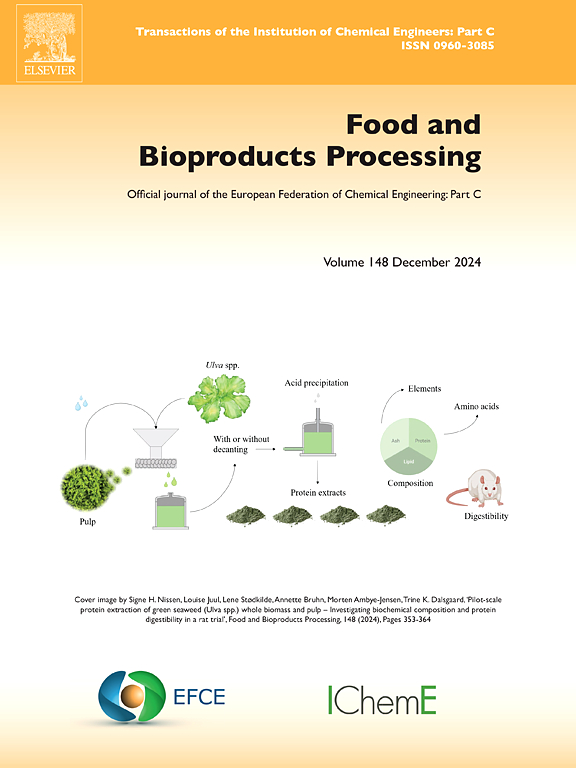Polymalic acid production from Chinese-liquor distillers grains by co-fermentation of glucose and xylose
IF 3.5
2区 农林科学
Q2 BIOTECHNOLOGY & APPLIED MICROBIOLOGY
引用次数: 0
Abstract
Chinese-liquor distillers grains (CDG) is an industrial organic waste due to its abundant unfermented polymeric sugars. In this study, CDG was used as the sole carbon and nitrogen source for polymalic acid (PMA) fermentation by Aureobasidium pullulans. The saccharification of CDG was conducted using 5 % (v/v) H2SO4 with a high solid-liquid ratio of 0.3, followed by resin-detoxification and cellulase hydrolysis. Glucose and xylose were obtained in CDG hydrolysate with a sugar recovery of 39.3 % and 51.3 %, respectively. A. pullulans utilized glucose and xylose simultaneously, but carbon catabolite repression was still observed. The co-fermentation of glucose and xylose yielded enhanced cell growth and sugar consumption, whereas sole-glucose fermentation resulted in higher PMA titer. After optimization, 38.6 ± 1.7 g/L of PMA was produced from CDG hydrolysate with a yield of 0.35 g/g sugar. This study provided an important biorefinery strategy for PMA production from CDG feedstock.
葡萄糖和木糖共发酵白酒酒糟生产聚苹果酸
白酒酒糟中含有大量未发酵的聚合糖,是一种工业有机废弃物。本研究以CDG为唯一碳氮源,利用普鲁兰毛霉发酵聚苹果酸(PMA)。采用5 % (v/v) H2SO4和0.3的高料液比对CDG进行糖化,然后进行树脂解毒和纤维素酶水解。从CDG水解物中得到葡萄糖和木糖,糖回收率分别为39.3% %和51.3% %。普鲁兰同时利用葡萄糖和木糖,但仍观察到碳分解代谢抑制。葡萄糖和木糖的共发酵促进了细胞的生长和糖的消耗,而单独的葡萄糖发酵导致更高的PMA滴度。优化后,CDG水解产物的PMA产率为38.6 ± 1.7 g/L,糖的产率为0.35 g/g。该研究为从CDG原料中提取PMA提供了重要的生物精炼策略。
本文章由计算机程序翻译,如有差异,请以英文原文为准。
求助全文
约1分钟内获得全文
求助全文
来源期刊

Food and Bioproducts Processing
工程技术-工程:化工
CiteScore
9.70
自引率
4.30%
发文量
115
审稿时长
24 days
期刊介绍:
Official Journal of the European Federation of Chemical Engineering:
Part C
FBP aims to be the principal international journal for publication of high quality, original papers in the branches of engineering and science dedicated to the safe processing of biological products. It is the only journal to exploit the synergy between biotechnology, bioprocessing and food engineering.
Papers showing how research results can be used in engineering design, and accounts of experimental or theoretical research work bringing new perspectives to established principles, highlighting unsolved problems or indicating directions for future research, are particularly welcome. Contributions that deal with new developments in equipment or processes and that can be given quantitative expression are encouraged. The journal is especially interested in papers that extend the boundaries of food and bioproducts processing.
The journal has a strong emphasis on the interface between engineering and food or bioproducts. Papers that are not likely to be published are those:
• Primarily concerned with food formulation
• That use experimental design techniques to obtain response surfaces but gain little insight from them
• That are empirical and ignore established mechanistic models, e.g., empirical drying curves
• That are primarily concerned about sensory evaluation and colour
• Concern the extraction, encapsulation and/or antioxidant activity of a specific biological material without providing insight that could be applied to a similar but different material,
• Containing only chemical analyses of biological materials.
 求助内容:
求助内容: 应助结果提醒方式:
应助结果提醒方式:


